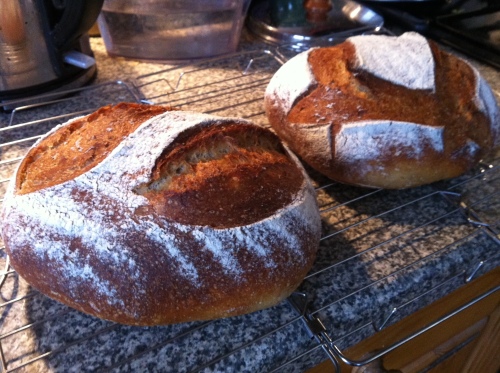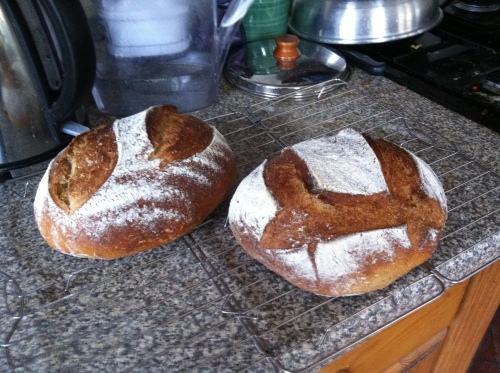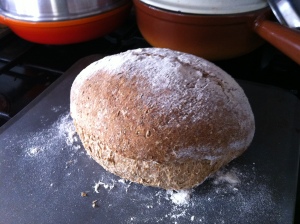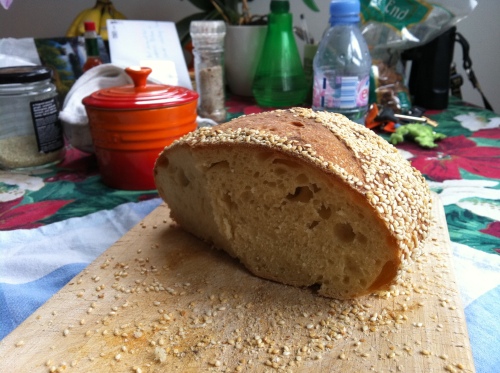 I always thought that a proper honeymoon was supposed to involve beaches and sleeping in a lot. But then I also thought that weddings were supposed to involve big, white dresses, ice sculptures of swans, and family rows, and I knew we weren’t having any of that either, so why sign up for a stereotypical honeymoon? Amsterdam seemed interesting, was quick to fly to, and neither of us had been there – oh, and it was possible we might find something good to eat, even if it was just classic Old World bread and cheese. So, done.
I always thought that a proper honeymoon was supposed to involve beaches and sleeping in a lot. But then I also thought that weddings were supposed to involve big, white dresses, ice sculptures of swans, and family rows, and I knew we weren’t having any of that either, so why sign up for a stereotypical honeymoon? Amsterdam seemed interesting, was quick to fly to, and neither of us had been there – oh, and it was possible we might find something good to eat, even if it was just classic Old World bread and cheese. So, done.
As it turned out there was plenty of good stuff to eat. The Time Out guidebook offered an enticing hint: that there were substantial snacks to be had, so that you wouldn’t starve between meals. One dilemma was that I have really been trying to lose a bit of weight. One the one hand we were on holiday so a bit of indulgence seemed OK, but on the other I did find myself making mental notes of calories consumed versus hours walked. And walk we did, until our feet hurt, although lot of that walking involved tracking down recommended food stops. Well, that is who I am.

Houses on the edge of the Vondelpark. You know you want to live there.
Tuesday evening, after getting settled in our hotel and having a quick wander in the Vondelpark, we hopped a tram to the Pijp, where efforts at upward mobility clashed gently with bohemian coffeehouse and immigrant cultures. This was evident in stoned graffiti on building-site plywood – for example, “A city sodomized by tentacles of distrust” – across from a pedestrian-only block filled with a variety of relaxed natives and tourists scattered amongst sidewalk cafés. Here, we learned our first bit of food-Dutch: Vlaamse friet, or Belgian (Flemish) fries, on offer alongside falafel. Yes, please. The menu had a bit of Hebrew on it, so I asked the guy in front of us if it was an Israeli shop; he told us most of the falafel shops in Amsterdam were run by Indians and, sure enough, some of the salads in the falafel bar had a touch of cumin and coriander seed, not what you’d find in Tel Aviv. Good though. More difficult to figure out was the long list of friet toppings; I picked the one that seemed most likely to be mayo, and it was. A satisfying snack indeed; we never got around to dinner that night, but after much walking we did succumb in the hotel bar to a (bad) slice of ‘New York’ cheesecake, which they seemed a bit too eager to get rid of.

Typical shop in the Pijp.
Breakfast was not included in our hotel package, for which I was thankful; I tend to eat too much mediocre food, just because it’s there, blowing my calories much too early in the day. We noted a cheese shop near to the hotel with an offer of belegte broodje met koffie, filled rolls and coffee. What more do you need, really? I chickened out and ordered in English, though, too scared of making a mistake. The choices were old, young and mild cheese; we got a young and an old, and I’m afraid I didn’t write down the names. The coffee, by the way, although obviously not the focus of the shop, was spot on, as would be each of the subsequent cups we drank in Amsterdam. How do they do that?
We had a good chunk of time that morning to explore the city centre, the Dam (main square), the red light district (how could I not? I’m a public health professional after all) and the Oude Kerk, the old church – right smack in the middle of the red light district, and there’s even a statue of a sex worker on the grounds. A classy little bakery with pretty sweets and really good bread was a few steps away, and we stopped in for an almond-curl biscuit, amandelkrull – I got an approving nod from the baker for sounding out the word correctly. Result! OK, that was an easy one. How about koekje? Am I right in guessing that this should be pronounced, approximately, ‘cookie’? We didn’t spend as much time in patisseries scrutinising the koekjes as we should have. Given that each cup of coffee was accompanied by a different one, I suspect that there is a whole new world out there. Anyway, here’s a pic of the window of the bakery in the red-light district:

Let's call it Munchies Bakery, since I can't remember what it was really called.
While we shared our amandelkrull and drank coffee, a young American guy came in. The proprietor threw a wry, knowing (but not unkind) glance to his assistant that said ‘You want to take this one?’ American guy proceeded to order, rather passionately, a brownie and a slice of carrot cake, at 11 am. It seems the many cannabis coffeeshops in the area are good for business.
That afternoon, after a light, leisurely lunch back in the Vondelpark – it’s so easy to get around! – with a friend and her lovely twin babbies, we braved threatening skies and headed over to the Jewish History Museum. We walked via the somewhat disappointing flower market – mostly tourist souvenirs, at this point, and to be honest (eek, don’t hate me!) I don’t even like tulips all that much. But if I lived there, I might pick up a few perennials. Amazingly, though cannabis seeds were on sale everywhere, I don’t believe I saw any growing, anywhere. (Perhaps it’s grown indoors? I ask purely out of theoretical interest, honest.)
One thing we knew we wanted to try in Amsterdam was Indonesian food, which seems to take the place of Britain’s Indian restaurants, since Indonesia was for a long time a Dutch colony. Our friend referred us to Orient, a family-run business near the famous Concertgebouw and the big art museums. Wednesday was buffet night, which made it easy to try many dishes – the equivalent of a rijstaffel? I managed not to overeat, but I could have done quite happily.

Bloemenmarkt
We shared a fabulously buttery almond croissant, nabbed earlier in the day, on the way back to the hotel. Perfect.
Thursday morning rained buckets on Amsterdam, so it was a good day to hit the museums, but first, breakfast. We had to try Bagels and Beans, if only because it looked like an inviting place for a sit-down. The menu was great, the coffee was again lovely, and some American students were happy to share the shop’s wifi password with us. The only disappointment with the breakfast was, I’m afraid, with the bagels themselves. They lacked that boiled, chewy quality and were somehow a bit crumbly.
Never mind; we survived, and were fed, and braved the queues for the Rijksmuseum. Delftware, check; Old Masters, check (except for the Vermeers, which were in The Hague); celebration of faded imperial glory, check. Truly, though, we love old Rembrandt – he’s a Master for good reason – and it was exciting to experience his work in person.
For lunch Thursday we wandered around the canals in search of a recommended sandwich shop. The wander was worthwhile in itself, but when we got to the shop, there was truly nothing on the long, mostly meat menu I really wanted, and the bread was only just meh.

A Delft violin, with strings and all. I can only imagine it sounds pretty weird.
Andrew bought one and I abstemiously settled on tangy frozen yogurt with berries, in preparation for the inevitable afternoon attack of the friet. We sneakily borrowed a seat outside the yogurt shop where I made myself available to help Andrew consume the biggest, sloppiest sandwich we’d ever seen, a takeaway item that really should have come with its own table, plate, cutlery and napkins.
Which brings me to the topic of mayonnaise. I love the stuff, but not as much as the Dutch do. It’s everywhere! The supermarket deli/ready-meal section we visited had shelves and shelves of mostly mayo salads and sandwiches. As noted above it’s the default topping for friet. Where do they put it all? Why are Amsterdammers not fat? I can only assume it’s because they cycle everywhere.
I found something better than mayo, or even ketchup (another Indonesian word!), for friet. After circling back around to the Portuguese synagogue, which we hadn’t fit in the day before, I did indeed get drawn in by the ubiquitous friet. This time, though, on a hunch, I asked if one of the sauces on offer was peanut-flavoured and, sure enough, I got satay, a rich, dark, sweetish, slightly spicy sauce that was better than those particular friet to be honest.
I wish I’d gotten a larger portion, but it was just as well I didn’t, as dinner – tapas, at Sal Gorda, not far from our hotel – was very filling indeed (the restaurant is much prettier than the website). And even though my Dutch is nonexistent, our lovely waiter was only too happy to speak Spanish! We had the classics here: marinated anchovies, Merguez sausage, a big bowl of olives, patatas bravas (with more mayo, natch), shrimp in garlic sauce, and more. As it was still light, I forgot it was 9 pm and ordered a cappuccino (just to go wash down the crema Catalana of course); amazingly, it didn’t keep me awake.
Friday morning – our last morning – was again rainy, and we breakfasted at Le Pain Quotidien, a Belgian chain that’s really very good, though I did find myself wondering if there was a seamy underbelly. They sell beautiful sourdough loaves, but when I asked the waiter if he’d had a chance to make them, he admitted that the loaves are prepared and shaped elsewhere, and only baked in the local shop. Fair enough…I suppose. It is a chain after all.
We weren’t sure these were the loaves we wanted to bring home, though, so we poked our heads in a few shops in this (very posh) neighbourhood and ended up in an organic grocery, where we bought a sourdough nut loaf and some young geitekaas (goats’ cheese), having previously bought some aged geitekaas, quite different, at a shop in town. And with our last few euros – luckily they didn’t take credit cards as we could’ve done some serious damage here – we bought some fruit jellies for Andrew’s mum, in the most beautiful sweet shop you’ve ever seen, Van Avezaath-Beune.

Café at Schiphol Airport. These wooden loaves looked better than the actual bread, unfortunately, but they had good coffee and free mini-stroopwaffels.
Amsterdam, we love you and will be back, armed with a better knowledge of Dutch… there is so much more to eat!






















